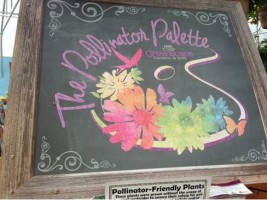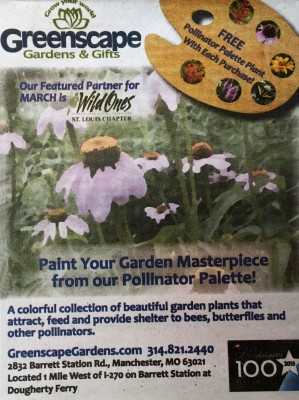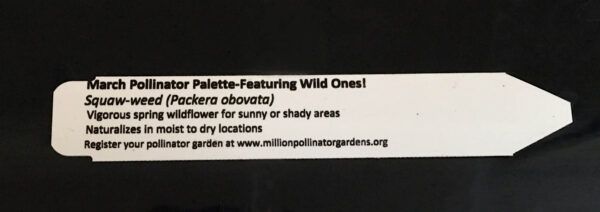By Dawn Weber
Board Member-at-Large, St. Louis Wild Ones
UPDATE: March 19, 10:00 a.m. – CANCELLED DUE TO WEATHER March 26 is still scheduled.
Each month a different native plant that serves as a nectar source or host plant will be featured as a gift with purchase at Greenscape Gardens.
This Pollinator Palette program was created to increase awareness and engagement in our communities for pollinator issues and the value of native plants. These events target gardeners of all ages, experience, and skill levels.
For 2016, like-minded community partners are being featured alongside each month’s plant to help raise awareness of that organization’s mission.
Jennifer at Greenscape said, “There is so much great work, education, and passion in St. Louis – We are very proud of our hometown!”
Through the month of March, St. Louis Wild Ones is the featured Pollinator Palette Partner.
The featured plant is squaw weed (Packera obovata), also known as round-leaved ragwort, which is a spring-flowering plant that keeps its green foliage throughout the year. It is a host plant for 17 species of butterflies and moths, including the northern metalmark. The nectar and pollen attract several species of bees, flies, and beetles.
During March, our very eye-catching pink Wild Ones sign is on display near the checkout. Rack cards, business cards, and 2016 Native Plant Garden Tour save-the-date fliers are also available to customers.
In addition, we will have Wild Ones volunteers at the nursery on two Saturdays to:
- Hand out squaw weed with information
- Provide some context about the importance of pollinators
- Promote our organization
We will have a table display featuring wildflower photos and will hand out the Native Plant Garden Tour bookmark with each plant, in addition to the other information that will be there all month.
During the spring rush, the lines can be long, which leaves the checkout staff with not much opportunity to educate and answer questions about the promotion. We will fill this role.
The volunteer dates and times are:
March 19, 10:00 a.m. – CANCELLED DUE TO WEATHER 1:00 p.m., volunteer spots filled- March 26, 10:00 a.m. – 1:00 p.m., need 1 more person
If you would like to volunteer, please contact Dawn.. If you are in the area, please stop by and say hello!
Thanks to Greenscape Gardens for helping us spread the word about Wild Ones!






I love this plant! Glad to see it featured! I would love to know your source for the info on butterflies and moths for this (and other) species.
It’s a little bit of detective work sometimes to put everything together, but here’s my method:
1) http://udel.edu/~dtallamy/host/
In the downloads section, the “Host Plants” link will take you to a spreadsheet of data produced by Dr Doug Tallamy (author of Bringing Nature Home) and his students that shows their research on the number of native butterfly and moth species that use a particular genus of plants as it’s host plant. The genus is just the first part of the plant’s scientific name, so in this case Packera because the scientific full name is Packera obovata. Sometimes using this sheet can be a little bit tricky because plants change names. Squaw-weed was formerly called Senecio obovatus, so where plants have changed names you may need to search for both.
2) http://www.butterfliesandmoths.org/ can be a good resource for learning the host plants of butterfly and moth species. There is a search box at the top left on the home page, and I typed in Packera obovata and got no results. So then I tried Senecio obovatus, and the link for the Northern Metalmark butterfly came up.
3) I also use http://www.illinoiswildflowers.info/ . There is a fair amount of plant species overlap between Illinois and Missouri so
4) Other than that, I just google “Packera obovatus host plant” and sift through the results, and try to crosscheck sources to be sure of the info.
You can also reverse the search, where you know the butterfly/moth and want to find out the host plants by googling “Northern Metalmark Host Plant”.
Maybe others have good host plant references that they’d like to mention?
Thank you! I did not know that the Tallamy list had been completed. I will definitely add it to my detective work folder!